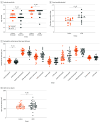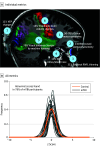Primary Visual Pathway Changes in Individuals With Chronic Mild Traumatic Brain Injury
- PMID: 39602146
- PMCID: PMC11603381
- DOI: 10.1001/jamaophthalmol.2024.5076
Primary Visual Pathway Changes in Individuals With Chronic Mild Traumatic Brain Injury
Abstract
Importance: Individuals with mild traumatic brain injury (TBI) often report vision problems despite having normal visual acuity and fundus examinations. Diagnostics are needed for these patients.
Objective: To determine if a battery of assessments or machine-learning approaches can aid in diagnosing visual dysfunction in patients with mild TBI.
Design, setting, and participants: This prospective, observational, case-control study was conducted between May 2018 and November 2021. The study setting was at a level 1 trauma research hospital. Participant eligibility included adult males and females with recorded best-corrected visual acuity and normal fundus examination. Individuals in the case group had a history of mild TBI; controls had no history of TBI. Exclusion criteria included a history of ocular, neurological, or psychiatric disease, moderate-severe TBI, recent TBI, metal implants, age younger than 18 years, and pregnancy. Cases and controls were sex- and age-matched. Data analysis was performed from July 2023 to March 2024.
Exposures: History of mild TBI in the case group.
Main outcomes and measures: The single-session visit included the Neurobehavioral Symptom Inventory and measurements of oculomotor function, optical coherence tomography, contrast sensitivity, visual evoked potentials, visual field testing, and magnetic resonance imaging.
Results: A total of 28 participants (mean [SD] age, 35.0 [12.8] years; 15 male [53.6%]) with mild TBI and 28 controls (mean [SD] age, 35.8 [8.5] years; 19 female [67.9%]) were analyzed. Participants with mild TBI showed reduced prism convergence test breakpoint (-8.38; 95% CI, -14.14 to -2.62; P = .008) and recovery point (-8.44; 95% CI, -13.82 to -3.06; P = .004). Participants with mild TBI also had decreased contrast sensitivity (-0.07; 95% CI, -0.13 to -0.01; P = .04) and increased visual evoked potential binocular summation index (0.32; 95% CI, 0.02-0.63; P = .02). A subset of participants exhibited reduced peripapillary retinal nerve fiber layer thickness, increased optic nerve/sheath size, and brain cortical volumes. Machine learning identified subtle differences across the primary visual pathway, including the optic radiations and occipital lobe regions, independent of visual symptoms.
Conclusions and relevance: Results of this case-control study suggest that the visual system was affected in individuals with mild TBI, even in those who did not self-report vision problems. These findings support the utility of a battery of assessments or machine-learning approaches to accurately diagnose this population.
Conflict of interest statement
Figures





Comment on
-
Visual Deficits in Patients With Mild Traumatic Brain Injury.JAMA Ophthalmol. 2025 Jan 1;143(1):43-44. doi: 10.1001/jamaophthalmol.2024.5121. JAMA Ophthalmol. 2025. PMID: 39602153 No abstract available.
References
Publication types
MeSH terms
Grants and funding
LinkOut - more resources
Full Text Sources
Medical

